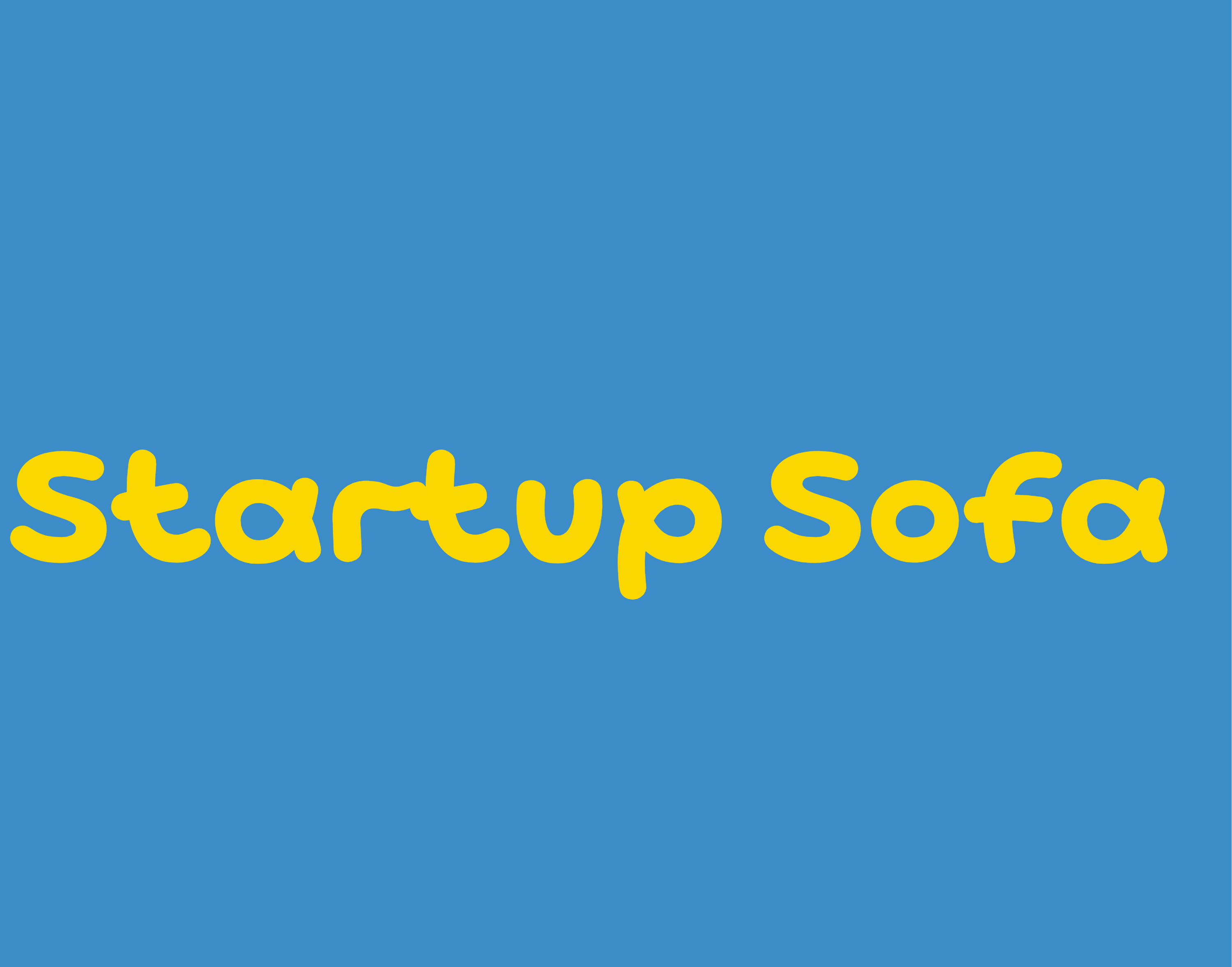Growing a Business
9 Ways to Get Serious About Your Work: Boost Productivity Now!
Discover essential strategies to enhance your productivity and transform your work ethic—are you ready to unlock your full potential?
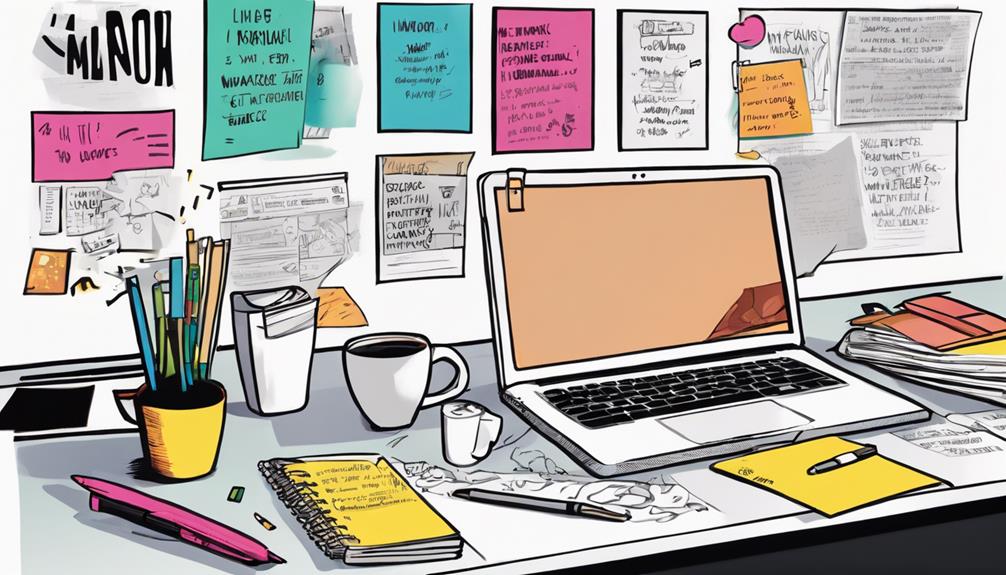
To get serious about your work and boost productivity, start by managing your energy wisely. Identify peak energy times and schedule tasks accordingly. Prioritize effectively using tools like the Eisenhower Matrix, and limit distractions by controlling notifications and maintaining a clutter-free workspace. Embrace healthy habits, such as staying hydrated and incorporating regular exercise. Utilize productivity tools and tech to streamline your tasks, and never stop learning to develop your skills. Ultimately, foster a positive work culture, as it can enhance morale and efficiency. Stick around, and you'll discover even more valuable strategies to elevate your performance.
Key Takeaways
- Identify your peak energy times and schedule complex tasks accordingly to maximize productivity.
- Implement the Pomodoro Technique to maintain focus and counteract fatigue through regular breaks.
- Use the Eisenhower Matrix to prioritize tasks by urgency and importance for better time management.
- Minimize distractions by turning off notifications and creating a clutter-free workspace.
Manage Your Energy Wisely
To boost your productivity, it's important to manage your energy levels effectively throughout the day. Understanding that your focus and motivation fluctuate can help you take control of your time management.
Start by keeping a journal for 1-2 weeks to identify your peak energy times. This way, you can schedule complex tasks when you're most alert and save simpler tasks for when your energy dips.
Incorporating regular breaks is vital, too. The Pomodoro Technique is a great tool here; work for 25 minutes and then take a 5-minute break. These short pauses not only prevent burnout but also help maintain your focus.
Setting hourly timers for stretching or quick movement breaks can further enhance your physical and mental clarity.
Prioritize Your Tasks Effectively

Managing your energy wisely sets the stage for prioritizing tasks effectively, guaranteeing you tackle what's most important when you're at your best.
Start by using the Eisenhower Matrix to categorize tasks based on urgency and importance. This method helps you focus on what truly matters, preventing overwhelm.
Limit your daily task list to 5-9 priorities by applying the 1-3-5 rule: choose 1 big task, 3 medium tasks, and 5 small tasks. This approach maintains clarity and focus throughout your day.
Additionally, implement timeboxing techniques by allocating specific time slots for each task, creating a sense of urgency that can enhance productivity.
Don't forget to regularly review and adjust your task priorities based on changing deadlines and project requirements. This guarantees you're always working on the most impactful activities.
Setting clear, measurable goals for each task is essential; it allows you to track progress effectively and maintain motivation while aligning your daily efforts with broader objectives.
Limit Distractions and Interruptions

Limiting distractions and interruptions is essential for maintaining focus and boosting your productivity at work. Multitasking is a myth; studies reveal that context switching can lower your productivity by up to 40%. To tackle this, dedicate specific focus hours during which you can concentrate solely on one task at a time.
Turning off notifications and entering 'Do Not Disturb' mode can greatly reduce interruptions, allowing for deeper concentration. Communicate your availability to colleagues, so they know when you're focused and can minimize disruptions.
Moreover, utilizing browser blockers and email filters can effectively curb environmental distractions, making your task management more efficient. A clutter-free workspace is equally vital; it not only reduces visual distractions but has been linked to improved concentration and productivity levels.
Optimize Your Workspace

To boost your productivity, start by optimizing your workspace.
Decluttering can sharpen your focus, while ergonomic design essentials like adjustable chairs and standing desks keep you comfortable.
These adjustments not only enhance your environment but also support your well-being, making it easier to get work done.
Ergonomic Design Essentials
Creating an ergonomic workspace is essential for enhancing comfort and productivity while minimizing the risk of injury. By applying ergonomic design principles, you can create an environment that not only feels good but supports your work efficiency.
Start with an adjustable desk that allows you to alternate between sitting and standing. Research shows that employees using standing desks report a 46% increase in productivity.
Next, invest in an ergonomic chair that offers adjustable height, lumbar support, and proper seat depth to improve posture and reduce back pain during long hours at your desk. Position your computer monitor at eye level, about an arm's length away, to minimize eye strain and neck discomfort.
Additionally, consider adding accessories like keyboard trays and wrist rests. These tools can improve your typing posture and decrease the risk of repetitive strain injuries.
Prioritizing ergonomic design in your workspace not only fosters a healthier working environment but also boosts your overall productivity. By making these adjustments, you'll be setting yourself up for success, allowing you to focus better and work more efficiently every day.
Declutter for Focus
Clearing away clutter from your workspace can sharpen your focus and greatly boost your productivity. A tidy environment reduces stress and enhances concentration, leading to a reported 20-30% increase in productivity. To achieve this, consider the following organization strategies:
| Action | Benefits | Tips |
|---|---|---|
| Declutter regularly | Saves up to 30 minutes a day | Set a weekly decluttering day |
| Use ergonomic accessories | Improves physical well-being | Invest in adjustable chairs |
| Incorporate plants | Enhances focus by up to 15% | Choose low-maintenance plants |
| Personalize your space | Increases engagement and belonging | Add motivational quotes |
| Implement storage solutions | Keeps items easily accessible | Use desk organizers |
Embrace Progress Over Perfection

Embracing progress over perfection means letting go of unrealistic expectations and focusing on completing tasks effectively. When you prioritize progress, you'll notice a boost in your productivity as you shift your mindset from seeking flawless results to celebrating achievements, no matter how small. This approach not only reduces stress but also fosters a healthier work-life balance.
Research shows that pursuing perfection often leads to anxiety and procrastination, hindering your progress. By recognizing this pattern, you can tackle tasks with a more constructive attitude. Instead of getting bogged down in details, aim for incremental improvements and regularly seek feedback.
This shift encourages a growth mindset, enhancing your resilience and adaptability in a dynamic work environment.
Cultivate Healthy Habits

To boost your productivity, it's crucial to cultivate healthy habits that support your well-being.
Staying hydrated, incorporating regular physical activity, and practicing mindfulness can greatly enhance your focus and energy levels.
Hydration and Nutrition
Staying hydrated and eating a balanced diet are essential for keeping your energy levels high and your mind sharp at work. Hydration plays a vital role in maintaining cognitive function; even mild dehydration can lead to decreased concentration and increased fatigue. Aim for at least 8-10 glasses of water daily to stay on top of your game.
A balanced diet rich in whole grains, lean proteins, fruits, and vegetables can greatly enhance your energy levels and focus. Regular meals that include omega-3 fatty acids—found in fatty fish and flaxseeds—can further improve brain health and cognitive performance, making you more productive throughout the day.
Don't forget about healthy snacks! Incorporating options like nuts and fruits can provide sustained energy and help you avoid the crashes that come from sugary snacks and processed foods.
Starting your day with a well-balanced breakfast is a game-changer; it can enhance memory and attention span, setting a positive tone for your work. By prioritizing hydration and nutrition, you're not just fueling your body—you're also boosting your productivity and overall work performance.
Regular Physical Activity
How can incorporating regular physical activity into your routine elevate your productivity and enhance your overall work experience? Engaging in just 30 minutes of moderate exercise most days can notably boost your productivity by up to 21%. This improvement comes from increased focus and energy levels, which are essential for enhancing workplace efficiency.
Taking short breaks for physical activity throughout your day can make a real difference. Try incorporating walking or stretching every hour. These small bursts of movement help improve concentration and decrease fatigue, making you more effective at your tasks.
Additionally, regular exercise can help reduce stress and anxiety levels, releasing endorphins that contribute to a positive work environment.
If your workplace offers wellness programs, consider participating. Research shows that employees who engage in regular physical activity through these programs report higher job satisfaction and lower absenteeism rates.
By cultivating healthy habits, you not only improve your mood and cognitive function but also create a more dynamic and productive work atmosphere.
Mindfulness and Stress Management
Incorporating mindfulness and stress management techniques into your daily routine can greatly enhance your focus and productivity at work.
By dedicating just 10 minutes a day to mindfulness practices like meditation or deep breathing, you'll not only reduce stress but also improve emotional regulation and cognitive performance. This simple shift can lead to a 30% increase in your productivity, making those tough days feel a bit lighter.
Here are some powerful benefits of mindfulness you can experience:
- Enhanced focus: Forgetting distractions becomes easier, allowing you to tackle tasks more effectively.
- Improved relationships: Practicing mindfulness fosters empathy and better communication with colleagues.
Regular mindfulness breaks throughout your workday are essential productivity tips. Even short pauses can recharge your brain, resulting in a 20% improvement in cognitive performance.
By embracing these practices, you'll transform your work environment into a more supportive space, where collaboration thrives and stress takes a backseat.
Prioritize mindfulness today, and watch your productivity soar!
Utilize Productivity Tools
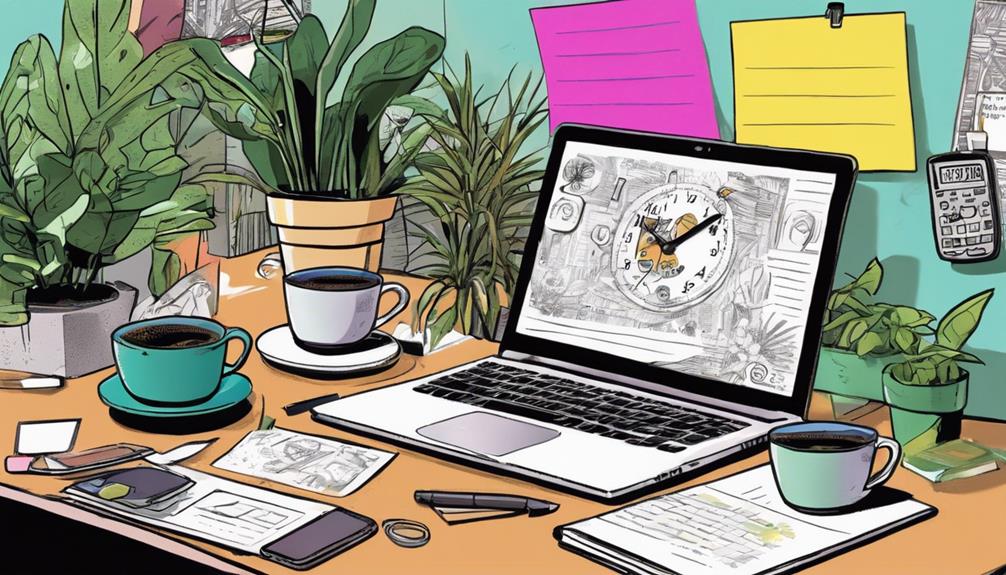
Leveraging productivity tools can dramatically enhance your workflow and help you manage tasks more efficiently. By implementing a solid task management strategy, you can prioritize and organize your workload effectively. Tools like Trello and Asana allow you to track tasks in a collaborative environment, ensuring you're always on the same page with your team.
Time management apps, such as Toggl or RescueTime, provide valuable insights into how you spend your time. By analyzing these patterns, you can adjust your work habits and maximize efficiency. Additionally, project management tools like Monday.com help you visualize project timelines, allocate resources wisely, and monitor progress, leading to smoother project execution.
Don't forget about automation; tools like Zapier can connect different applications and automate repetitive tasks, saving you precious time and reducing manual workload. Utilizing shared calendars, such as Google Calendar, also enhances team coordination by keeping everyone informed about deadlines and meetings.
Invest in Continuous Learning

To truly elevate your productivity, investing in continuous learning not only enhances your skills but also equips you to tackle new challenges effectively. When you engage in ongoing education, you become more adaptable and better prepared for the demands of your role. This commitment to employee development can lead to significant benefits for both you and your organization.
Consider the following emotional impacts of continuous learning:
- Increased confidence in your abilities as you master new skills.
- Stronger job satisfaction through opportunities for career development.
Participating in training programs can boost your performance by up to 20%, allowing you to work more efficiently and effectively. Additionally, companies that prioritize continuous learning report a 34% higher retention rate, which means they value their employees' growth.
Remember, organizations that encourage skill development are 62% more likely to innovate. By investing in your continuous learning journey, you're not just enhancing your productivity; you're also positioning yourself as a key asset in your workplace.
Embrace learning, and watch your career flourish!
Foster a Positive Company Culture

Fostering a positive company culture not only boosts employee morale but also drives productivity and engagement across the organization. When you create an environment that values communication and transparency, you can see a significant increase in employee productivity—up to 30%. This positive culture reduces turnover rates by 50%, saving you both time and money on hiring and training new staff.
Celebrating team achievements and recognizing individual contributions can further enhance morale, leading to a 12% increase in employee satisfaction scores. Regular team-building activities promote better communication and collaboration, resulting in a 25% boost in project efficiency. When employees feel connected and valued, they're more likely to contribute positively to team dynamics.
Moreover, establishing a culture of trust through open communication can lead to a 40% increase in overall trust levels within your workforce. This supportive environment not only nurtures individual growth but also enhances collective performance.
Conclusion
By applying these nine strategies, you'll transform your work routine into a well-oiled machine.
Just like a garden thrives with the right care and attention, your productivity will blossom when you manage your energy, prioritize tasks, and create a supportive environment.
Embrace progress, cultivate healthy habits, and invest in your growth.
Remember, each small step you take is a seed planted for future success.
Now, go ahead and watch your productivity flourish!
Growing a Business
Mastering Customer Retention for Business Success
Navigating the complexities of customer retention can unlock unprecedented growth for your business—discover the strategies that can make all the difference.

Mastering customer retention is essential for your business's success and growth. It's often cheaper to keep existing customers than to acquire new ones. You can enhance retention by understanding customer needs and offering tailored upsell opportunities. Designing an engaging loyalty program can encourage repeat purchases and build trust. Additionally, exceptional customer service makes a big difference in how customers perceive your brand. By measuring key metrics like customer churn and lifetime value, you can track your progress. Discover how to implement these strategies effectively and watch your business thrive.
Key Takeaways
- Prioritize customer retention as it is more cost-effective than acquiring new customers, ensuring long-term sustainability and profitability.
- Implement effective upselling strategies by understanding customer needs and offering complementary products that enhance their initial purchases.
- Design loyalty programs with clear rewards and achievable milestones to encourage repeat purchases and customer engagement.
- Enhance customer service by actively listening to concerns, personalizing interactions, and ensuring prompt resolutions to build trust and loyalty.
Importance of Customer Retention
Customer retention is essential because it costs considerably less to keep existing customers than to acquire new ones.
When you focus on retaining your current customers, you're building on the trust they've already established with your brand. This trust opens doors for upselling, as customers are more likely to evaluate additional products or services that enhance their experience.
Offering complementary items can deepen relationships and increase your revenue. Sometimes, businesses even sell initial products at a loss to attract a customer base, planning strategic upsells for later.
Strategies for Effective Upselling

Focusing on effective upselling strategies can greatly enhance your customer retention efforts and boost revenue from your existing clientele.
Start by understanding your customers' needs and preferences; this knowledge allows you to recommend relevant products or services. Offer complementary items that enhance their initial purchase, creating added value. Position higher-ticket items as premium options to elevate their experience.
Timing is key; suggest upsells during the purchase process or shortly thereafter, while their interest is high. Make the upsell process seamless—use persuasive language that highlights benefits without being pushy.
Ultimately, train your staff to recognize upselling opportunities and engage customers naturally, ensuring they feel valued rather than pressured.
Designing Loyalty Programs

To create an effective loyalty program, you need to clearly define the rewards and benefits that will resonate with your target audience. Consider what motivates your customers—whether it's discounts, exclusive access, or points redeemable for future purchases.
Next, set achievable milestones that encourage engagement, making sure the rewards feel attainable yet valuable. Keep communication transparent; let customers know how they can earn points and redeem rewards.
Also, implement a tiered structure to incentivize higher spending, giving loyal customers more reasons to stay engaged. Regularly evaluate and adapt your program based on customer feedback and behavior data, ensuring it evolves with your audience's needs and preferences.
This way, you'll foster long-lasting relationships and enhance customer retention effectively.
Enhancing Customer Service

Excellent service builds trust and loyalty, ensuring your customers keep coming back for more.
To enhance your customer service, focus on these key strategies:
- Listen actively: Understand your customers' needs and concerns by giving them your full attention.
- Train your team: Equip your staff with the skills and knowledge to address issues effectively and empathetically.
- Be responsive: Address inquiries and complaints promptly, showing your customers that you value their time.
Measuring Retention Success

Measuring retention success involves analyzing key metrics that reveal how well your business keeps customers engaged and satisfied over time. To effectively gauge your retention efforts, focus on metrics such as customer churn rate, repeat purchase rate, customer lifetime value, and net promoter score.
Here's a simple overview of these metrics:
| Metric | Description |
|---|---|
| Customer Churn Rate | Percentage of customers lost over a specific period |
| Repeat Purchase Rate | Frequency of customers returning to make purchases |
| Customer Lifetime Value | Total revenue expected from a customer during their relationship |
| Net Promoter Score | Measure of customer loyalty and satisfaction |
Conclusion
Mastering customer retention isn't just beneficial; it's essential for your business's success.
Did you know that increasing customer retention rates by just 5% can boost profits by 25% to 95%?
By implementing effective upselling techniques, creating engaging loyalty programs, and prioritizing exceptional customer service, you can transform one-time buyers into lifelong advocates.
Start focusing on these strategies today, and watch your customer relationships flourish, leading to sustainable growth and profitability in the long run.
Growing a Business
Branding: Product First or Core Values
Can a brand thrive by prioritizing products over core values, or is the true key to success hidden in a delicate balance?

When considering branding, it's essential to balance product features and core values. You want your products to stand out, but your brand's identity should reflect what you believe in. Strong brands often lead by highlighting their unique value proposition, which resonates with consumer perceptions. Your core values can create trust and foster loyalty, while your products must meet consumer needs effectively. Focusing on both aspects helps secure a solid market position. Remember, understanding this balance is key to long-term success and recognition in the marketplace, and there's more to explore about effective strategies.
Key Takeaways
- Successful branding often balances product offerings with core values, ensuring alignment with consumer perception and expectations.
- A strong brand foundation emphasizes unique value while integrating core values to resonate with target audiences.
- Early marketing should reflect both product design and the brand's core values to avoid misalignment with consumer needs.
- Brands that prioritize core values can foster trust and loyalty, enhancing long-term success in the marketplace.
Understanding Branding Essentials
Branding essentials start in your prospect's mind, shaping how they perceive your product and its place in the market.
To build a successful brand, you need to understand that it often revolves around pioneering new categories. Think about Google in search or Coca-Cola in soft drinks; they've set the standard.
Your goal should be to own a specific category in the consumer's perception, whether that's as a leader, number two, or even an also-ran.
Focus on the unique value you bring, which differentiates your brand.
Remember, it's not just about what you sell, but how you're seen in the minds of consumers.
Establishing a strong brand foundation is vital for long-term success and recognition.
Navigating Market Positioning

To navigate market positioning effectively, you need to clearly define where you want your brand to stand in relation to competitors. Consider your unique value proposition and how it differentiates you in the market. Here's a simple table to help you visualize your positioning strategy:
| Positioning Strategy | Example Brands | Key Differentiator |
|---|---|---|
| Market Leader | Coca-Cola | Brand heritage |
| Strong No. 2 | Pepsi | Innovative flavors |
| Niche Player | LaCroix | Health-focused offerings |
| Emerging Challenger | Spindrift | Unique fruit flavors |
Role of Early Marketing

Early marketing plays an essential role in shaping product design and production, ensuring that consumer needs and perceptions guide development from the outset.
By engaging with potential customers early on, you gather valuable insights that inform your product strategy. This proactive approach helps you avoid costly missteps, as it aligns your offerings with market demand.
Consulting with marketing experts can enhance your understanding of consumer behavior, allowing you to craft a compelling message that resonates.
Moreover, achieving first-mover advantage can set you apart, as seen with Chobani's rise in the Greek yogurt market.
Strategies for New Entrants

Understanding how to position your brand effectively is essential for new entrants in a competitive market. Start by identifying a niche where you can differentiate yourself from existing players.
You've got two main strategies: create a new category or narrow your focus. For instance, if you're entering a saturated market, consider targeting a specific consumer need that isn't being met.
Look at brands like Earth's Best and Silk, which successfully carved out new categories. Alternatively, if you can't create a new category, hone in on a particular aspect of your product, like BMW did with driving performance.
Aligning Consumer Perception

Aligning your brand with consumer perception is essential for achieving lasting success in the marketplace. You need to understand how consumers view your brand and guarantee that your messaging resonates with their values and expectations. This alignment creates trust and loyalty, ultimately driving sales. Here's a simple framework to help you assess your brand alignment with consumer perception:
| Aspect | Consumer Expectation |
|---|---|
| Quality | High standards of excellence |
| Innovation | Cutting-edge solutions |
| Trustworthiness | Transparency and honesty |
| Customer Service | Responsive and helpful support |
| Social Responsibility | Commitment to ethical practices |
Conclusion
In the vibrant tapestry of branding, your product and core values are the threads that weave together your identity.
By prioritizing both, you create a masterpiece that captivates your audience's hearts and minds.
As you begin this journey, remember that a brand isn't just a name; it's a story that resonates.
So, whether you're crafting a sleek gadget or a heartfelt mission, let your values shine through, guiding you to a lasting connection with consumers.
Growing a Business
Leonard Riggio: Revolutionizing Book Retail
Leonard Riggio's innovative approach to book retail transformed shopping into a cultural experience, but what challenges did he face along the way?

Leonard Riggio revolutionized book retail by transforming the shopping experience into a cultural outing. Starting as a clerk, he expanded the Student Book Exchange and later acquired Barnes & Noble, where he introduced superstores. You'll find comfortable seating and coffee, creating inviting spaces for exploration. Riggio's customer-centric approach combined innovative features like discount strategies and the Sales Annex, redefining how you engage with books. Despite facing criticism from independent bookstores, he emphasizes adapting to technology for the future. You'll see how his vision might shape the next chapter in the book retail industry.
Key Takeaways
- Leonard Riggio transformed book retail by acquiring Barnes & Noble and introducing a customer-centric superstore model.
- He created inviting spaces with seating and coffee services, making bookstores cultural hubs for relaxation and exploration.
- Riggio's innovative retail strategies included aggressive discounting and showcasing remaindered books, attracting a loyal customer base.
- His approach sparked criticism from independent bookstores, highlighting challenges in maintaining market competition.
Early Career Beginnings
Leonard Riggio kicked off his bookselling journey in the early 1960s as a clerk at the NYU bookstore, where he discovered his passion for the industry. You can imagine the excitement he felt surrounded by books and enthusiastic students.
After dropping out of college at 24, he took a bold step by investing $5,000 to open the Student Book Exchange (SBX) in 1965. His vision extended beyond just selling books; he aimed to create a community hub for students.
As SBX thrived, expanding to four additional campus bookstores in NYC, Riggio's determination set the stage for a remarkable career in retail. This foundational experience shaped his approach to bookselling, blending commerce with a genuine love for literature.
Expansion of SBX and Barnes & Noble

The success of the Student Book Exchange (SBX) quickly led to its expansion across multiple campuses in New York City, ultimately paving the way for Riggio's acquisition of Barnes & Noble in 1971, which transformed the book retail landscape.
You'd notice that SBX's innovative approach attracted a loyal customer base, making it an attractive opportunity for Riggio.
After acquiring Barnes & Noble for $1.2 million, he shifted its focus from traditional retail to a more modern, customer-centric model. This move not only expanded his influence but also set the stage for future growth.
Innovations in Book Retailing

With the acquisition of Barnes & Noble, Riggio transformed traditional bookselling by introducing innovative retail concepts that turned bookstores into vibrant community spaces.
He redefined the shopping experience by creating superstores, filled with comfortable seating and coffee services, inviting customers to linger. You'll find an entertainment vibe in these spaces, where browsing books feels more like a relaxing outing than a chore.
Riggio also embraced mass-market retailing, employing aggressive discount strategies that attracted a broader audience. The Barnes & Noble Sales Annex showcased remaindered books and free newspapers, enhancing foot traffic and customer engagement.
This shift not only boosted revenue but also established bookstores as essential cultural hubs, redefining how you perceive and interact with literature.
Customer Experience Transformation

Transforming customer experience, Riggio focused on creating inviting spaces where you could relax, explore, and enjoy books like never before. He understood that a bookstore shouldn't just be a retail space; it should feel like a community hub.
By introducing comfortable seating and coffee services, he turned Barnes & Noble into a destination for readers. You could spend hours browsing, sipping coffee, and discovering new titles in a cozy atmosphere.
Riggio's vision extended beyond mere transactions; he aimed to enhance your connection to literature. The superstore model didn't just increase sales; it redefined how you experienced shopping for books, making it a pleasurable outing rather than a chore.
This transformation laid the groundwork for a new era in book retail.
Industry Challenges and Criticism

While Riggio's innovations in creating inviting bookstore environments garnered praise, they also sparked significant criticism from independent bookstores facing challenges in the evolving retail landscape.
You might feel the tension as these smaller shops struggled to compete with Barnes & Noble's superstore model, which dominated the market.
Critics argue Riggio's approach pressured publishers into exclusive deals, limiting choices for consumers and stifling diversity in the industry.
You can see how independent booksellers, often community-focused, faced hurdles in maintaining their customer base amidst aggressive pricing and marketing strategies.
This disruption led to a broader conversation about the future of bookselling, raising questions about sustainability and the potential loss of unique voices in literature as larger chains continued to expand their reach.
Vision for the Future

Envisioning a future shaped by technological advancements, Riggio anticipates a significant evolution in the publishing landscape, focusing on the integration of online services for accessing books.
He believes that the way readers discover and interact with literature will transform through digital platforms, creating a more personalized experience. You can expect features like instant access to a vast library, interactive content, and tailored recommendations based on your preferences.
Riggio sees this shift not just as a convenience but as a means to foster a deeper connection between readers and authors. By embracing these innovations, you'll find that bookstores will likely evolve into hybrid spaces, blending the physical and digital domains to enrich your reading journey and community engagement.
Adapting to Technological Change

As the publishing landscape evolves, bookstores must adapt to technological changes that enhance the reader experience and streamline access to literature. Embracing these innovations is vital for staying relevant.
Here are some key strategies you can implement:
- Integrate e-commerce: Optimize your website for online sales and inventory management.
- Utilize social media: Engage with your audience through platforms like Instagram and Facebook.
- Offer digital content: Provide eBooks and audiobooks to cater to diverse reading preferences.
- Incorporate technology in-store: Use tablets for browsing or self-checkout stations to improve efficiency.
Conclusion
Leonard Riggio's journey is a tapestry woven with ambition and innovation, transforming the book retail landscape into a vibrant marketplace.
He didn't just open stores; he crafted inviting havens for readers, where books and community intertwined like threads in a quilt.
As the pages of the industry turn, his visionary approach continues to inspire, reminding us that adaptability and foresight can illuminate even the darkest corners of change.
Riggio's legacy is a beacon for the future of book retailing.
-

 Startup Stories and Case Studies4 months ago
Startup Stories and Case Studies4 months agoStartup Stories and Case Studies: Learn from Success
-
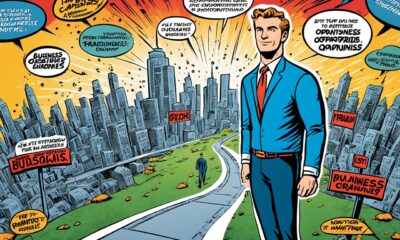
 Franchises4 months ago
Franchises4 months agoExploring Franchises: Your Path to Business Ownership
-

 Business Planning4 months ago
Business Planning4 months agoCraft a Robust Business Plan: Your Guide to Success
-

 Business Planning4 months ago
Business Planning4 months agoDefine Your Products and Services: A Crucial Step
-

 Business Planning4 months ago
Business Planning4 months agoAnalyze Your Competitors: Gain a Competitive Edge
-
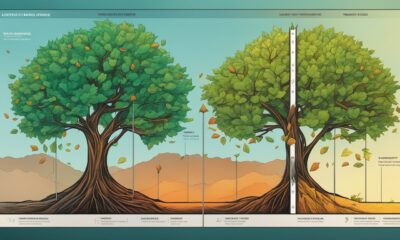
 Funding4 months ago
Funding4 months agoUnderstanding How Startup Funding Works
-

 Franchises3 months ago
Franchises3 months agoFast Food Franchises Dominating the Market
-

 Startup Stories and Case Studies4 months ago
Startup Stories and Case Studies4 months agoFrom Humble Beginnings to Shark Tank Success
